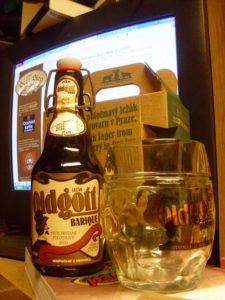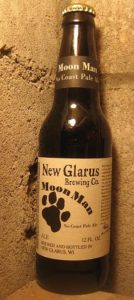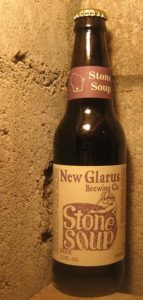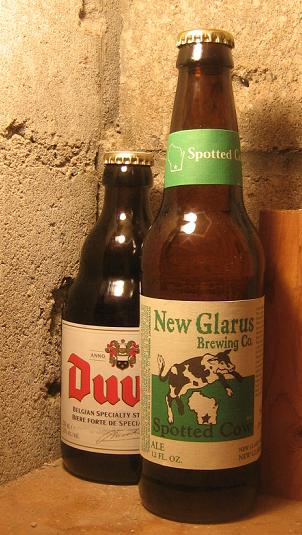See that up there? That’s the news of the week. Maybe news of the week last week but are you really the news of the week if you don’t stretch it out to two weeks? That’s a crop from Kat Sewell‘s image from Les Twits and it is one of many out there. Everyone is fascinated in the UK with blue and white cardboard suitcases apparently. On BlueSky, it’s the easy-to-carry box that makes the deal according to B+B… but then we learned of this sad take from one unhappy Pete:
You’re quite possibly right. However by contrast, the box I picked up was damaged and required two hands to carry it. I then had to transport it on my push bike. I ditched the box in the store bin and carried all 10 bottles (loose) in my back pack. It was quite heavy.
Update: there was a yesterday post on Belgian Smaak by Eoghan that Jordan pronounced “It’s some of the best writing I’ve read this year on any subject” so I better include a link here. It’s on the Belgian tram line I believe I mentioned a few months back. But Eoghan has way more detail in his story “Flavour Track — A Culinary Crawl On Belgium’s Coastal Tram“:
…my early morning train from my home in Brussels—skating past wet, flat polder fields with pitched roof village steeples occluded by an early morning mist—terminates in the village of Adinkerke and its well-proportioned brick train station. From here, the sea is a 45 minute walk through corn fields and acorn-strewn dunes, where the entrance to Belgium is marked by a Leonidas chocolate shop housed in a former customs station. By the time the train pulls into the sidings at Adinkerke the mist has congealed into a fine rain. Fortunately, there are already two trams waiting to start their journeys up the coast.
Nice! What else is making folks happ-happ-happy? Kids in pubs? Really? This spot near Manchester apparently hopes so:
It’s wonderful to head out to a countryside pub for a cool drink on a sunny day – but for those without a car, public transport options are often quite limited in getting to some of the region’s prettiest villages. But it’s not something you have to worry about when heading to Mobberley in Cheshire – where there’s a brilliant village pub right next to the train stop. The Railway Inn (in a nod to its convenient location) has been widely acclaimed with both CAMRA beer awards in recent years, as well as with rave reviews from visitors on Tripadvisor. Reviews from this year hail it as a “hidden gem” with its huge beer garden and brilliant play areas for kids. The pub also boasts its own bowling green.
Seems like a huge investment on the pub’s part. To make youg families happy. Kids are great. Right? Not always if the news out of New York City is to be believed:
A crime tale straight out of Charles Dickens is unfolding in the Big Apple — with adults “directing” children who appear no older than 10 to steal from unsuspecting businesses, witnesses told The Post. The chubby-cheeked crooks have terrorized bars on the east and west side of Manhattan and Brooklyn for months, graduating from snatching money in unattended bags to stealing cash from open safes in at least two watering holes in the last few weeks, according to workers and owners. In many cases, the kids at first try to solicit money to raise money for their “basketball team,” and then run amok.
OK, what else… is this a bad idea or a good one? Announcing you are raising pub prices to deal with those times of the week with busier workloads?
Britain’s biggest pub chain has started charging its customers 20p extra for a pint during busy trading periods. Stonegate Group, which owns more than 4,500 pubs across the UK, has begun adding a surcharge at peak times at 800 of its sites across the country. A ‘polite notice’ in one Stonegate pub said ‘dynamic pricing is currently live in this venue during this peak trading session’. The sign says the surcharges will pay for extra staff, extra cleaning, plastic pint glasses, and ‘satisfying and complying with licensing requirements’. The notice explains that ‘any increase in our pricing today is to cover these additional requirements.’
It’s referred to as dynamic pricing and it is not receiving a warm welcome: “Tom Stainer, chief executive of the Campaign for Real Ale, a consumer group, called the move troubling…” Wow, there’s a strong statement. The proprietor of the Ypres Castle himself is not clear on the point at all and goes even further: “It’s utterly weird, isn’t it. Surely the thing to have done was to raise prices overall but introduce long happy hours, achieving the same thing but spinning it positively.” Wetherspoon pubs are doing the opposite – lowering the price – but just for one day:
It’s that time of year again when all Wetherspoon pubs slash all food and drink by 7.5 per cent. The annual move is to highlight the benefit of a permanent VAT reduction in the hospitality industry. And that means that if you pop into a Wetherspoon’s on Thursday, September 14, then, to mark Tax Equality Day, you will get some money knocked off. That means a customer who spends a tenner will only pay £9.25 for example. Wetherspoon’s founder and chairman, Tim Martin, said: “The biggest threat to the hospitality industry is the vast disparity in tax treatment among pubs, restaurants and supermarkets.
And while you are out there looking for bargains, just be clear about the rules:
When people on Trip Advisor are still advising tourists to go to Samuel Smith pubs for good value food and beer, however, there’s clearly a mismatch between reality and reputation. We might also be more relaxed about these prices if we felt they were covering the costs of a good pub experience but… Dirty glassware. Glum service. Grim atmosphere. Evidence of a death spiral, perhaps?
Spicy!!! But enough of your obsessions with filthy lucre. Time to go all ag and to that end Stan has reported in from the hopyards on the effects of climate change before taking a bit of a break over the next few weeks:
The photos at the top and bottom were taken in USDA research fields near Prosser, Washington. The babies in the seedling field (top) are cute, don’t you think? The odds are very much against them ending up with a name and being used to brew beer. But if that happens, farmers will know they are agronomically prepared to survive in a climate wild hop plants in Mongolia did not know five million years ago. A constant topic of discussion last week was the Great Centennial Disaster. In recent years, farmers in the Yakima Valley have harvested about seven to eight bales of Centennial per acre planted. This year, some fields produced only two-plus bales per acre. Not every field was such a disaster, but when the USDA releases harvest data in December the results will not be pretty.
More on this phenomenon in The New York Times where Catie Edmondson providing extended coverage from the hop fields of Spalt, Germany:
The plant is so central to the town’s culture that signs advertising “Spalter Bier” can be found on nearly every street, many of them hanging from the half-timbered, red-roof houses that were built hundreds of years ago to store and dry hops. But the crop and those timeworn traditions are being threatened like never before. The culprit is climate change. The promise of a warming, drier climate has dealt a brutal hand to the hops industry across Europe. But it has been especially ruthless to Spalter, a crop that has sustained this tidy town of 5,000 in southern Germany for centuries.
And Martin continues his quest for pubs but took a break to go to a rainy music fest where he and herself still found their way down country lanes to a pub:
One of the annual traditions at End of the Road, along with watching Mrs RM put the day tent up while we watch and spilling curry down our new T-shirts, is a half hour walk along the narrow lanes to the Museum for a pint of Sixpenny’s 6d Best in a proper glass. Yes, missing last food orders (which seem earlier each year) is also a Retired Martin tradition. So this time we earmarked Saturday lunchtime for a visit, and with the promise of morning WiFi we set off at 10:30 on the “jumping into hedge to duck incoming lorries” routine. It’s worth it for the thatch.
Nice. Similarly but without all the hassles of the actual travel, Gary continued his wanderings around the pubs of the UK in the mid-1900s with this post about a 1940 exhibition of paintings at the National Gallery in Britain on the Blitz including this scene from Wales:
Perhaps, then, the pub next to theh Masonic Hall was St. Ives, also known as St. Ives Inn. Or if not it was presumably one of the other four known to have traded on Caer Street before 1939. Whichever pub it was, one can only hope that it wasn’t occupied when Hitler’s bomb fell. The Masonic Hall, for its part was not occupied; Swansea Masons had shut its doors a few years earlier when they moved to a new location.
It reminds me of how common “getting blitzed” is for slang among my pals. Speaking of which, Cookie wrote a post this week, about the Hillgate Mile pub crawl in and around Stockport:
The hillgate mile was many years ago an iconic pub crawl in and around Stockport. A strip with a high density of pubs that had come about to service high density housing and factories in the area. Much of that housing had become flats and many factories closed and with it the need for so many pubs. The area and its pubs was in decline when I first encountered it and whilst now there has been a revitalisation of the area with new build nicer looking flats there will never be demand for that number of pubs again. It was noted not only for the number of pubs but the variety of brewers that owned pubs under the tied system.
His remembrances about these sorts of endings are worth the read. And reminded me that a few weeks ago, I cast doubts upon the notion that in Britain “Cask is the only beer poured beneath the bar where you can’t see what’s going on and this greatly adds to the uncertainty around it.” Is it really about the show that draws people into pubs, that they are now missing out on? Well, a form of that notion appears to have maybe crossed an ocean if this observation in GBH is to be believed as a major factor in the continuing decline of draft… something that has been on the steady decline for decades:
Draft beer, even when brewed by a multinational beer company, absorbs context from its setting: the bartender who poured it, the adjacent guest on the barstool, the glassware in which it’s served. Adding a humble orange slice to a glass of Blue Moon elevated the way millions of U.S. drinkers thought about beer. In packaged form, beer has fewer tools to pitch itself to drinkers. It works with the same set of variables as any other beverage in a can or bottle, whether wine or pre-made cocktails or hop water.
I am pretty sure that is not the problem, people no longer hankering for an orange slice and a stranger on the next barstool. Again, its only about the relative value proposition and, as with cask lovers in the UK, dive bar beer drinkers are just not as big a part of the population, maybe just because they have found something else to do. Sober up. Collect stamps. Get a happier family life. Netflix. Something. I am also very mindful of the frank words of Katie Mather in her newsletter The Gulp! this week on the closing of her bar Corto:
I want to be clear about the reality of opening a bar like Corto in a small, rural town—even one as permanently lauded in the national press as being the “ideal beer staycation destination”. Last week we opened and drank three bottles of Riesling worth £100 because after three attempts to drum up interest in a tasting event (which we have been repeatedly told by well-meaning folks that we should do more of) only two people came along. The world of premium and craft drinks is not what it was, or what we believe it to be. I sell three times as much basic organic Tempranillo as I do orange wine or sour beers.
In another sort of ending, Andrew Cusack in The Spectator considers the his low alcohol coping mechanism in his remembrances of Sam Smith’s now departed, his beloved Alpine Lager:
Sam Smith’s Brewery has sadly failed to realise the strength of Alpine’s weakness. There has been a downward trend of the main lagers, such as Carlsberg which has reached 3.8 (and which has announced they will move down to 3.4 this year as well) and Fosters at 3.7 per cent. But almost nothing exists in the peak quaffable-but-still-tasty range of 2 to 3 per cent. Many of Sam Smith’s loyal customers will mourn the passing of the Alpine decade and hope that some other brewery might take note of the open territory before them.
Over at Pellicle, Ruvani de Silva has written about a lager in England which is dedicated to the Windrush generation as well as the people and the process behind its development:
If that sounds like a lot to pack into one beer, that’s because it is. Robyn, however, talks passionately about how immigration has shaped her, her family, and her community, consolidating and distilling her thoughts and feelings into brewing a beer that she wants to speak for those experiences, and to resonate with those both inside and outside the Caribbean diaspora.
On this side of the Atlantic, the hippytown of Guelph, Ontario has announced one of the more attractive beer bus deals as Jordan explains:
Running September 16, October 14, November 18, and December 16, the beer bus is a great solution to the logistical problems behind your next afternoon pub crawl… Five breweries, more than five dozen beers on tap, two full food menus to choose from, buses running once an hour, and the best part is that it’s free! Donations are accepted on the bus and proceeds go to a scholarship fund at the Niagara College Brewing program. If you can think of something better to do with your Saturday afternoon than go to Guelph, I’d like to hear about it.
Free! Free is good. Except free runnings. Unexpectely free. Which leads us, finally, to the saddest drinky clinky video of the week: “Streets flooded with wine after tanks burst at Levira, Portugal distillery.” Here is the background:
This is the moment a flood of red wine surged down a street in Portugal after two massive tanks with enough booze to fill a swimming pool burst. Winemakers Levira Distillery were due to bottle the 2.2 million litres when the giant tanks suddenly gave way in Sao Lourenco do Bairro on September 10. Video footage showed a huge, fast-moving river of red wine flowing down a hill and around a bend as baffled locals look on.
Yikes! And that is that. Done. Still no drunk elephant stories this week. I looked again. I really tried, Stan. Still, as per always and forever, you can check out the many ways to find good reading about beer and similar stuff via social media and other forms of comms to connect – even including at my somewhat quieter than expected Threads presence @agoodbeerblog. Got on BlueSky this week and added it to my IG, FB, X, Mastodon, Threads, Substack Notes and a deservedly dormant Patreaon presence. I am multi! I am legion!! Yet totally sub. All in all, I still am preferring the voices on Mastodon, like these ones discussing beer:
Alan McLeod | A Good Beer Blog (… me…)
Stan Hieronymus | The Man!
Boak & Bailey | The B² experience
Curmudgeon Ale Works | Jonathon is Brewing
Katie Mather | Shiny Biscuit and Corto
David Jesudason | “Desi Pubs” (2023) author
BeoirFest | They say “Let’s Talk Beer”
Ron Pattinson | The RonAlongAThon Himself
Al Reece AKA Velky Al | Fuggled
Jennifer Jordan | US hops historian
Andreas Krennmair | Vienna beer and lager historian
Beer Ladies Podcast | Lisa Grimm and colleagues
The Bar Towel | Toronto’s chat zone for beer lovers
Chicago Beer Society | Folk in Chicago getting social over beer
Jay Brooks | Brookston Beer Bulletin
Joe Stange | Belgian beer expert, beer magazine editor
Cider Bar | Barry makes Kertelreiter cider
Laura Hadland | CAMRA historian and beer writer
Brian Alberts | US beer historian
Jon Abernathy | The Beer Site
Maureen Ogle | US Beer Historian
Lars Garshol | Norwegian Beer Historian and Kveik Hunter
James Beeson | Beeson on Beer
Carla Jean | MAINER!!!
Thandi Guilherme | Beer Ladies Podcast Co-host
Lisa Grimm | Beer Ladies Podcast Co-host
Roy of Quare Swally | Beery ramblings from Northern Ireland
Rob Talksbeer | Podcaster and Youtuber
Anthony Gladman | UK Drinks Writer
Jeff Alworth | Manna Of Beervana
Northwest Beer Guide | Fairly self explanatory… but not NW Latvia…
Evan Rail | Prague based GBH editor, freelance writer, NYT etc.
Todd Alström | 50% of the Alströms
Jacob Berg | Beer talking librarian
Anyone else? And, yes, we also check the blogs, podcasts and newsletters to stay on top of things (though those things called “newsletters” where 1995 email lists meet the blogs of 2005 may be coming to an end of value if the trend with so many towards the dull dull dull means anything) including more weekly recommendations from Boak and Bailey every Saturday and Stan at his spot on those Mondays! Get your emailed issue of Episodes of my Pub Life by David Jesudason on many Fridays. And Phil Mellows is at the BritishBeerBreaks. Once a month, Will Hawkes issues his London Beer City newsletter and do sign up for Katie’s now much more occassional but always wonderful newsletter, The Gulp, too. Ben’s Beer and Badword is back! And check out the Atlantic Canada Beer Blog‘s weekly roundup. There is new reading at The Glass. Any more? Yes! Check to see the highly recommended Beer Ladies Podcast. And the long standing Beervana podcast . There is the Boys Are From Märzen podcast too and check out the travel vids at Ontario’s own A Quick Beer. There is more from DaftAboutCraft‘s podcast, too. All About Beer has introduced a podcast. There’s also The Perfect Pour. Plus follow the venerable Full Pint podcast. And the Craft Beer Channel on Youtube soon celebrating a decade of vids. And remember BeerEdge, too, and The Moon Under Water… if you have $10 a month for this sort of thing… I don’t. Pete Brown’s costs a fifth of that. There was also the Beer O’clock Show but that was gone after a ten year run but returned renewed and here is the link!





 Does that make sense? My co-workers have family in Wisconsin which means I get a share in
Does that make sense? My co-workers have family in Wisconsin which means I get a share in 

 This is the second in my
This is the second in my 